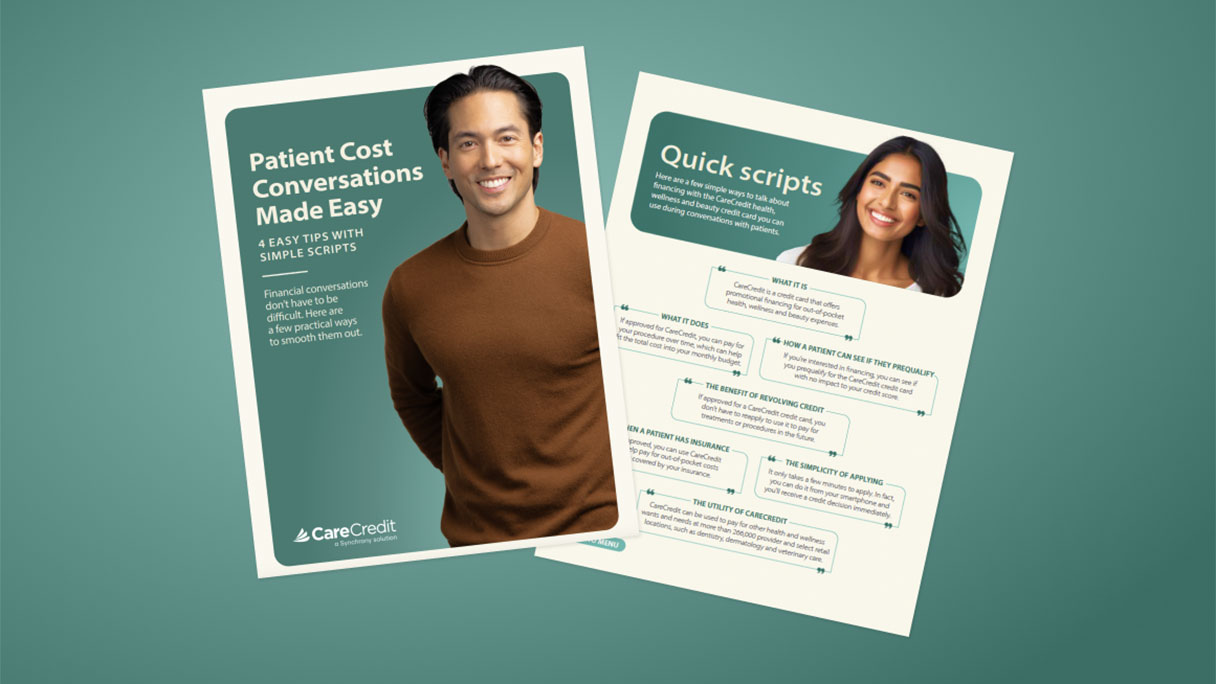7 Benefits of Healthcare Cost Transparency for Patients and Providers
Here’s why price transparency is good for both patients and providers — and how your practice can implement or improve patient estimates.
By Robyn Tellefsen
Digital Writer
Posted Sep 05, 2025 - 6 min read

Key Takeaways
- Cost transparency can help patients feel more informed, prepared and confident about care decisions by helping reduce unexpected bills and enabling better financial planning.
- For providers, offering clear and accurate estimates can help strengthen trust, improve payment timeliness and give practices a competitive edge.
- With the right tools, training and communication strategies, practices can create a smoother financial experience that can benefit both patients and staff.
Did you know that, of more than 1,000 patients surveyed by Experian Health in 2024, 96% want an accurate estimate of costs before treatment — and 43% would call off their procedure without it?1
This desire for transparency isn’t surprising given the rising costs of healthcare, which can translate to higher out-of-pocket costs for patients. By making healthcare cost transparency a priority in your practice, you may help patients avoid unexpected bills — and help improve the patient financial journey and boost patient retention.2
The Need for Transparency in Healthcare
Healthcare cost transparency refers to the availability of readily accessible information on the prices of healthcare services. This information can help define the value of healthcare services and enable patients to identify, compare and choose providers that offer the value they seek.3
Some of the most relevant costs for patient decision-making? Out-of-pocket expenses. For insured patients, these expenses may consist of deductibles, coinsurance or copays.4
Here are three key reasons healthcare cost transparency matters:
Rising healthcare costs
According to the Synchrony Lifetime of Healthcare Costs study, Americans surveyed who were insured with an employer-sponsored health insurance plan can expect to spend more than $320,000 (including premiums and out-of-pocket costs) over their adult lifetime. This number could be more than double — nearly $700,000 — for those who purchase their own insurance.5
Given the high cost of care, it’s no surprise that more than 1 in 4 Americans surveyed worry about or can’t pay off healthcare debt.5 However, providing upfront cost estimates may alleviate financial anxiety and help patients plan for care.2
Unexpected healthcare expenses
No one wants to be caught off guard by unexpected healthcare bills.2 Yet that may often be the case, as Synchrony's study found that healthcare costs are nearly 1.5 times higher than what most people estimate:5
- Patients think they spend $850 in a year.
- Patients actually spend $2,100 in a year.
Over a lifetime, this means surveyed patients underestimate their out-of-pocket expenses by around $76,250, which may leave them financially unprepared.5 But when patients understand potential treatment costs up front, they can better avoid unexpected expenses and make informed decisions about care.2
Missed payments
Lack of price transparency may also lead to missed payments.6 As a result, providers may spend significant time and resources chasing and collecting payments.7 Upfront cost estimates can lead to on-time payments, reducing the administrative burden of dealing with payment disputes and delays.6
Benefits of Healthcare Cost Transparency for Patients
Consider these four patient-centered benefits of healthcare price transparency:
1. Improved decision-making
Price transparency enables patients to make informed decisions about their care, empowering them to shop around and choose providers and services based on cost and value. This can be especially helpful for those with chronic conditions or ongoing care concerns.6
2. Increased trust and satisfaction with providers
Providing upfront, transparent pricing can help build trust between patients and providers, enhancing the overall patient experience.2 And when patients and providers engage in cost discussions, patients report higher satisfaction with care.4
3. Better financial planning and management
Healthcare cost transparency can help patients plan for care and avoid unexpected expenses that may lead to collections.2 In fact, 81% of patients say an accurate estimate helps them better prepare to pay for care.8
4. Better health outcomes
When patients are fully aware of their financial responsibility, they’re more likely to move forward with care and adhere to treatment. And sticking with the care plan can lead to better health outcomes and greater patient satisfaction.2
Benefits of Healthcare Cost Transparency for Providers
Consider these three benefits of healthcare cost transparency for healthcare providers:
5. Enhanced patient-provider relationships
Healthcare providers have an opportunity to build trust with patients through cost transparency — the kind of trusting relationship that can help keep patients coming back.2
6. Competitive advantage
Practices that list their prices online may see significant increases in patient volume and satisfaction.9 In other words, patients may be more likely to select a provider with known prices than one without — potentially giving your practice an edge in the healthcare marketplace.10
7. Reduced administrative burdens
Upfront cost estimates can enhance patient perception about the services they've received and, in turn, encourage prompt payments. After all, patients who feel in control of their financial situation are less likely to miss payments, helping your team avoid staff burnout resulting from excessive billing inquiries and disputes.6
Implementing Cost Transparency in Practice
Eighty-eight percent of providers surveyed say there’s an urgency to improve or implement accurate patient estimates.8 If you’re wondering how to provide cost transparency in your practice or organization, consider these strategies:
Take advantage of technology
You’re not on your own to help patients figure out the cost of care — technology solutions are available to increase accuracy in cost estimation and help reduce staff burnout.1 By investing in an online price estimator tool, your practice or organization can provide patients with user-friendly estimates of their out-of-pocket costs and the total cost of care based on prior cases.11 If the patient has health insurance, pricing tools can automatically apply the coverage details, including copays, coinsurance and deductibles.11
Note, however, that ensuring accuracy in cost estimation can be a challenge. For example, many estimator tools only account for patients’ primary insurance, which can lead to inaccurate estimates for those who are covered by more than one plan. Additionally, an episode of care may involve multiple providers who bill independently of each other, placing the burden on patients to obtain separate pricing information from each provider.4
As you consider various price transparency tools, look for solutions that are comprehensive, easy to navigate and capable of providing accurate and patient-specific out-of-pocket estimates.4
Balance transparency with privacy concerns
While the Health Insurance Portability and Accountability Act (HIPAA) protects patients’ rights to privacy over their health information, it can also make the disclosure of health data challenging. To balance these competing concerns, it’s essential to adopt strong security measures in your practice, such as encryption technologies and multifactor authentication, to safeguard sensitive patient data. Staff members should also be trained to protect patient privacy while promoting informed decision-making.12
Train staff to communicate costs effectively
Seventy-seven percent of patients surveyed say it’s important that their provider can explain what their insurance covers before treatment.8 This is an opportunity for your staff to lean on your price estimator tool to help patients understand the cost of care. It’s also an opportunity to discuss flexible ways to pay.
For example, when your practice offers flexible financing with the CareCredit credit card, you can use its payment calculator to show patients their estimated monthly payments. Empowering patients with transparent pricing and payment tools can build trust and help them fit care into their budget.8
Enhancing Transparency in Healthcare
The high cost of healthcare can translate to unexpectedly high out-of-pocket costs for patients. But with upfront, accurate and transparent healthcare pricing, your practice can give patients the information they need to make better decisions and budget for recommended care, thereby increasing patient satisfaction and loyalty to your practice.2
You can also invite your patients or clients to explore Synchrony CareCredit’s Fair Financing Principles hub, where they can find helpful resources to guide their financing decisions, such as how deferred interest financing works, how to read a billing statement, use a procedure calculator and more.
A Patient Financing Solution for Health and Wellness Providers
If you are looking for a way to connect your patients with flexible financing that empowers them to pay for the care they want and need, consider offering the CareCredit credit card as a financing solution. CareCredit allows cardholders to pay for out-of-pocket health and wellness expenses over time while helping enhance the payments process for your practice or business.
When you accept CareCredit, patients can see if they prequalify with no impact to their credit score, and those who apply, if approved, can take advantage of special financing on qualifying purchases.* Additionally, your practice or business will be paid directly within two business days.
Learn more about the CareCredit credit card as a patient financing solution or start the provider enrollment process by filling out this form.
Author Bio
Robyn Tellefsen is a freelance writer and editor with more than 20 years of experience covering health and wellness, finance and more. Her work has appeared on sites such as LoopNet, Beachside Rehab, First Horizon Bank, SoFi, A Place for Mom, American Express, Chase and more.
Healthcare payment and financing solution
The CareCredit health and wellness credit card helps improve the payment experience for patients and clients, and your financial performance.
Get StartedReady to help more patients and clients get the care they want and need?
Get StartedReady to help more patients and clients get the care they want and need?
Get Started*Subject to credit approval.
The information, opinions and recommendations expressed in the article are for informational purposes only. Information has been obtained from sources generally believed to be reliable. However, because of the possibility of human or mechanical error by our sources, or any other, Synchrony and any of its affiliates, including CareCredit, (collectively, “Synchrony”) does not provide any warranty as to the accuracy, adequacy, or completeness of any information for its intended purpose or any results obtained from the use of such information. The data presented in the article was current as of the time of writing. Please consult with your individual advisors with respect to any information presented.
© 2025 Synchrony Bank.
Sources:
1 “The state of patient access 2024,” Experian Health. April 29, 2024. Retrieved from: https://www.experian.com/blogs/healthcare/the-state-of-patient-access-2024/
2 “How patient estimates improve healthcare price transparency and planning,” Experian Health. August 27, 2024. Retrieved from: https://www.experian.com/blogs/healthcare/how-patient-estimates-improve-healthcare-price-transparency-and-planning/
3 “Price transparency: Common definitions,” Association of American Medical Colleges. Accessed August 22, 2025. Retrieved from: https://www.aamc.org/media/25851/download
4 Araich, Harman et al. “Healthcare price transparency in North America and Europe,” British Journal of Radiology. September 3, 2023. Retrieved from: https://pmc.ncbi.nlm.nih.gov/articles/PMC10607402/
5 2022 CareCredit Lifetime of Healthcare Costs, CareCredit. August 2022. (CareCredit is a Synchrony Solution). Lifetime cost is based on annual estimates of insurance premiums and out of pocket costs provided by survey respondents and extrapolated over an adult lifetime (ages 18 - 79).
6 “Price transparency is a top priority — how can providers respond?” Experian Health. April 12, 2023. Retrieved from: https://www.experian.com/blogs/healthcare/price-transparency-is-a-top-priority-how-can-providers-respond/
7 Healthcare Journey Research Consumers and Providers report, Synchrony, 2023. (CareCredit is a Synchrony solution.)
8 “The state of patient access 2025,” Experian Health. April 28, 2025. Retrieved from: https://www.experian.com/blogs/healthcare/the-state-of-patient-access-2025/
9 Bernstein, David N. and Crowe, Jonathan R. “Price transparency in United States’ healthcare: A narrative policy review of the current state and way forward,” Inquiry. May 26, 2024. Retrieved from: https://pmc.ncbi.nlm.nih.gov/articles/PMC11129567/
10 Nourmohammadi, Niki and Sadigh, Gelareh. “Patients, practice and price transparency: The impact of disclosing healthcare costs on consumer decision-making,” Clinical Imaging. March 2024. Retrieved from: https://www.sciencedirect.com/science/article/pii/S089970712300284X#bb0030
11 “Fact sheet: Price estimator tools,” American Hospital Association. January 2024. Retrieved from: https://www.aha.org/toolkitsmethodology/fact-sheet-price-estimator-tools
12 “Healthcare data privacy and security in the USA,” Health Information and Publications Network. April 17, 2024. Retrieved from: https://www.hipnet.org/healthcare-data-privacy-and-security-in-the-usa.html




